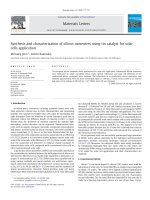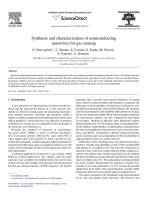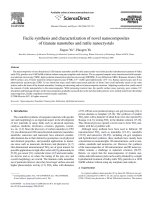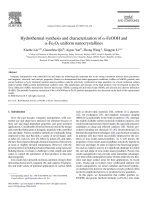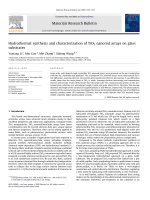- Trang chủ >>
- Khoa Học Tự Nhiên >>
- Vật lý
Synthesis and characterization of semiconducting nanowires for gas sensing
Bạn đang xem bản rút gọn của tài liệu. Xem và tải ngay bản đầy đủ của tài liệu tại đây (781.1 KB, 6 trang )
Sensors and Actuators B 121 (2007) 208–213
Synthesis and characterization of semiconducting
nanowires for gas sensing
G. Sberveglieri
∗
, C. Baratto, E. Comini, G. Faglia, M. Ferroni,
A. Ponzoni, A. Vomiero
SENSOR Lab of CNR-INFM and Dipartimento di Chimica e Fisica per l’Ingegneria e per i Materiali,
Brescia University, via Valotti 9, 25133 Brescia, Italy
Available online 27 October 2006
Abstract
Quasi one-dimensional nanostructures of semiconducting metal oxides are promising for the development of nano-devices. Tin, indium, and zinc
oxides were produced in form of single-crystalline nanowires through condensation from vapor phase. Such a growth occurs in controlled thermo-
dynamical condition and size reduction effects on the electrical and optical response to gases have been exploited. Preparation, microstructural,
and electrical characterization of nanowires are presented and the peculiarities of these innovative structures are highlighted.
© 2006 Elsevier B.V. All rights reserved.
Keywords: Nanowires; SnO
2
;In
2
O
3
; ZnO; Ozone
1. Introduction
A new generation of nanostructures has been recently pro-
duced and has attracted the interest of a wide research com-
munity [1]. These fascinating quasi one-dimensional nanostruc-
tures, namely nanowires, nanorods, and nanobelts, exhibit a
single-crystalline arrangement and feature unusual electrical and
optical properties, which arise from size reduction or quantum
confinement as crystal size is comparable to the wavelength of
the electronic wave-function [2].
Presently, the synthesis of nanowires of semiconduct-
ing metal oxides (MOX) is based on thermal decomposi-
tion of precursor powders followed by vapor–solid (VS) or
vapor–liquid–solid (VLS) growth [3]. Such a growth in con-
trolled thermodynamic condition appears highly promising for
nanostructure fabrication, due to its simplicity and low cost with
respect to the technology of silicon processing and to other top-
down approaches.
A potential application of nanowires is gas sensing, which
MOX are widely employed for. Tin-, indium-, and zinc-oxide
nanowires may constitute the building blocks for a novel class
of nano-devices. Some authors of the present work demonstrated
first the gas sensing properties of SnO
2
nanowires [4]. Indeed,
∗
Corresponding author.
E-mail address: (G. Sberveglieri).
nanowires may overcome some typical limitations of sensing
layers based on polycrystalline nanostructures. In general, the
fabrication of polycrystalline sensing layers is directed to con-
trol diffusion phenomena, which greatly influence the structural
and electrical properties and contribute either positively or nega-
tively to the long-term stability. Most of thetechniquesemployed
for conventional synthesis (sol–gel, condensation from liquid
or gas phase, chemical or physical vapor deposition) require
thermal treatment [5–8]. Calcination, firing, or annealing defini-
tively stabilizes stoichiometry, crystalline phase, and determines
the other non-equilibrium characteristics such as porosity, inter-
faces, and defects. Unfortunately, thermal treatment promotes
grain coarsening and causes degradation of the functionality by
suppressing the surface-to-volume ratio [9].
Differently, newly developed quasi one-dimensional nanos-
tructures envisage long durability owing to their exceptionally
high degree of crystallinity [10]. The transverse dimension of
nanowires may result even smaller than the Debye length asso-
ciated to the surface space-charge region and in such condition
the detection efficiency of gas molecules adsorbedatsurface may
reach very high value [11]. This extraordinary sensing potential
has been recently demonstrated for operation in liquid envi-
ronment or at room temperature [12–14]. Among the possible
applications in the field of bio-nanotechnology, sensitive DNA
and protein detection are presently under investigation [15].
This paper summarizes the preparation and characterization
of tin, zinc and indium oxide nanowires. The electrical and
0925-4005/$ – see front matter © 2006 Elsevier B.V. All rights reserved.
doi:10.1016/j.snb.2006.09.049
G. Sberveglieri et al. / Sensors and Actuators B 121 (2007) 208–213 209
Table 1
Basic operating parameters for nanowire growth from vapor condensation
Nanowires Precursor Decomposition
temperature (
◦
C)
Substrate
temperature (
◦
C)
Duration (min) Pressure (mbar) Substrate Catalyst
Sn oxide
SnO
2
1370 330 30 100 Poly-Al
2
O
3
Absent
SnO
2
1370 470 30 100 Poly-Al
2
O
3
Pt
Zn oxide
Zn 600 600 30 1000 Poly-Al
2
O
3
Absent
Zn 600 600 30 1000 Silicon Absent
In oxide In
2
O
3
1500 1100 60 100 Poly-Al
2
O
3
Absent
optical properties of nanowires were investigated with particular
regard to gas sensing behavior.
2. Experimental
The growth of MOX nanowires from vapor phase is based on
the evaporation–condensation technique [10]. The oxide pre-
cursor powder is placed at the center of an alumina tube and
then temperature is raised above the limit of decomposition for
the oxide (from 600
◦
C for zinc oxide to 1500
◦
C for indium
oxide) [16]. A controlled flow of inert gas (usually argon) is
maintained during decomposition and the overall pressure mea-
sures hundreds of mbar. The temperature gradient downstream
the gas flow promotes condensation of cations on clean alumina
substrates and allows interaction with the residual oxygen. The
peculiar thermodynamic conditions promote growth of nano-
sized one-dimensional structures instead of equi-axed grains.
Fig. 1 shows the nucleation of indium oxide nanowires as
achieved by the evaporation–condensation process. The SEM
image shows the crystal habit for the nanowires: the section
appears to be squared and the apex of the wires is tapered. In
Fig. 1. Nucleation of indium oxide nanowires over polycrystalline alumina.
general, no epitaxial relationship between the orientation of the
wire and the alumina grains has been observed. Control over the
direction of growth as well as pattering of the substrates may be
achieved by assisting the growth mechanism through dispersion
of catalysts [17].
By varying the operating conditions, nanostructures can be
produced with different length and shapes [18]. During tem-
perature transients, the argon flow is reversed in order to pre-
vent uncontrolled condensation. Table 1 summarizes the basic
operating parameters for production of SnO
2
, ZnO, and In
2
O
3
nanowires. Despite the deposition technique is relatively simple,
cleanness of the alumina tubes and purity of the atmosphere are
the key factor for the reproducibility of deposition.
3. Microstructural characterization
Scanning and transmission electron microscopy (SEM and
TEM) have been carried out in order to determine the degree
of homogeneity and crystalline arrangement. High-resolution
TEM imaging is useful for investigation of the termination of
the nanowire lateral sides and apex. Electron diffraction (ED)
and analysis of zero-order and higher-order Laue-zones allows
precise determination of unit cell and space group.
Incoherent imaging techniques such as STEM with the High-
Angle-Annular-Dark-Field detector (STEM-HAADF) were
used for the investigation of the shape of the nanowires and
impurities and local variations in the composition (Z-contrast).
3.1. SnO
2
nanowires
The nanowires prepared featured a very high aspect ratio
as the length exceeds several microns and the width is smaller
than 100 nm. As shown in Fig. 2a, the length and width of the
nanowire measure 25.3 m and about 50 nm, respectively. The
length and flexibility allows nano-manipulation for removal and
positioning over Si-based substrates for functional characteriza-
tion (see Fig. 2b). High-resolution TEM and electron diffraction
showed that the wire is single crystalline, with atomically sharp
termination of lateral sides. Measured Bragg reflections and the
whole symmetry of the ED pattern (see Fig. 2c) agree with the
cassiterite tetragonal SnO
2
phase (P42/mnm - SG 136). The
direction of the electron beam is parallel to the [0 1 0] zone-axis
of the reciprocal lattice and the nanowire grows along to the
[1 0 0] direction.
210 G. Sberveglieri et al. / Sensors and Actuators B 121 (2007) 208–213
Fig. 2. Characteristics of SnO
2
nanowires: (a) low-magnification TEM image of a very long SnO
2
nanowire, (b) removal of nanowires from the alumina substrate
through manipulators for structural and electrical characterization, (c) ED pattern of nanowire, (d) STEM-HAADF image of a nanowire, and (e) linescan of the
HAADF signal (solid line) and numerical fit of the shape of the nanowire (dashed line).
As both composition and phase can be considered uniform for
the crystalline SnO
2
nanowire; STEM-HAADF directly visu-
alizes variations in the projected thickness. Fig. 2d shows a
STEM-HAADF image of a SnO
2
nanowire, about 45 nm in
width: the contrast of the wire is not constant along its section,
indicating a variation of thickness. The thickness fitted from
HADDF profile measures 48 ± 0.2 nm (see Fig. 2e), based on
the approximation of a circular section of the wire. A width-
to-thickness ratio very close to 1 may thus be considered. The
asymmetry of the line profile with respect to the circular fit curve
indicates that the shape of the wire section is more likely to be a
regular polyhedron, as it is expected for a wire with crystalline
habit and crystal facets as lateral sides.
3.2. In
2
O
3
nanowires
Synthesis of indium oxide nanowires is difficult because of
the high temperature required for decomposition of the pre-
cursor oxide [18]. In addition, In
2
O
3
usually crystallizes in a
highly symmetric cubic structure, and the thermodynamic con-
ditions required for producing anisotropic growth are critical
to achieve.
The SEM image, presented in Fig. 3a, shows two nanowires
of indium oxide. The wires are capable to bend because of their
very small transverse dimension. TEM analysis (see Fig. 3b
and c) highlighted that the nanowires are single crystalline. ED
determined that the crystalline phase for the nanowire is Ia−3
body-centered cubic In
2
O
3
and that the growth direction is par-
allel to the [1 0 0] direction.
3.3. ZnO nanowires
ZnO nanowires may be produced at relatively low decom-
position temperature (see Table 1); the size and shape of the
obtained nanowires is however sensitive to the condensation
condition. Fig. 4 shows that ZnO nanowires smaller than 10 nm
in width can be produced. The capability to control the lateral
dimension of the nanowires will allow the systematic investiga-
tion of size reduction effects on the electrical and gas sensing
behavior of ZnO nanowires.
Fig. 3. Characteristics of In
3
O
2
nanowires: (a) SEM image of In
3
O
2
nanowires, (b) TEM image of nanowire 70 nm in width, and (c) ED pattern from the nanowire.
G. Sberveglieri et al. / Sensors and Actuators B 121 (2007) 208–213 211
Fig. 4. Characteristics of ZnO nanowires: (a–c) variation of the size for the ZnO nanowires for different growth conditions, (d) TEM image of ZnO crystalline
nanowire, (e) high-resolution TEM image of the hexagonal nanowire lattice, and (f) digital diffractogram and sketch of the indexed Bragg reflections.
TEM observation confirms the regular crystalline arrange-
ment for the nanowires. No evidences of extended crystal defects
governing the growth have been recorded. The high-resolution
TEM image and the corresponding digital diffractogram indicate
that the lattice symmetry is hexagonal and that the longitudinal
direction of growth is parallel to the c-axis of the crystal unit
cell.
4. Electrical characterization
For the electrical characterization, the electrical Pt contacts
were deposited by sputtering, while a Pt heating meander is
realized on the opposite side of the substrate.
Gas sensing characterization was carried out by volt-
amperometric technique; the sensors were biased by 1 V and the
electrical current was measured by a picoammeter. The refer-
ence atmosphere of synthetic air was maintained at the constant
condition of 0.3 l/min flow, 20
◦
C temperature, and 50% relative
humidity.
Nanowires were tested towards ozone generated by a UV
lamp discharge. Its concentration was measured at the chamber
outlet by a detector based on the wet chemical Brewer–Milford
principle.
Fig. 5 shows that SnO
2
nanowire and In
2
O
3
nanowires exhibit
good response towards ozone together with an appreciable capa-
bility to distinguish among different ozone concentrations. The
complete recovery of the baseline value after ozone injection
indicates that no poisoning effects occurred, as is sometimes
encountered for conventional MOX-based sensors in sensing of
oxidizing species [19].
ZnO nanowires exhibit low response to ozone. By observ-
ing the dynamic of response, three processes with different
time constant can be observed: a quick decrease in conductance
occurred after the ozone injection and is followed by a conduc-
tance increase; finally a very slow process prevented the sensor
response from reaching a steady-state value even after 1 h from
ozone injection. Despite this phenomenon, the response keeps
reversible.
The high response of the nanowires can be attributed
to their small lateral dimension. Indeed, when the lateral
dimensions of the nanowire are sufficiently reduced, then the
nanowire can be completely depleted and the response to gases
increases [20].
Fig. 6 shows the ozone sensing capability of SnO
2
and In
2
O
3
nanowires as a function of the operating temperature. ZnO
nanowires are not reported because of their slow response. The
highest response is obtained for an operating temperature of
400
◦
C for both the samples.
5. Optical characterization
Photoluminescence (PL) spectroscopy was performed over a
wide temperature and wavelength range for the purpose of inves-
tigating the effect of adsorbed gases on the optical properties of
zinc oxide nanowires.
As visible in Fig. 7, the PL in the visible and ultra-violet
region of the light spectrum is quenched by 12 ppm of NO
2
. The
Fig. 5. Variation of current as function of ozone concentration for (a) SnO
2
nanowires operated at 400
◦
C, (b) ZnO nanowires operated at 350
◦
C, and (c)
In
2
O
3
nanowires operated at 400
◦
C. The reference atmosphere is synthetic air
at 20
◦
C and 50% relative humidity.
212 G. Sberveglieri et al. / Sensors and Actuators B 121 (2007) 208–213
Fig. 6. Response of the nanowires of SnO
2
(solid line), and In
3
O
2
(dashed line)
as a function of the operating temperature. Ozone concentration is 280 ppb.
Fig. 7. Spectrum of photoluminescence at room temperature for ZnO nanowires
in dry air (open squares), 20 min after NO
2
introduction (open triangles) and
20 min after dry air restoration (open circles).
effect is fast (time scale order of seconds) and fully reversible.
The amplitude of quenching achieves its maximum at room
temperature and the influence of humidity and other reducing
gases is negligible. This feature could be interesting for applica-
tion of nanowires as a selective optical sensor working at room
temperature.
6. Concluding remarks
Nanowires of semiconducting MOX can be effectively pro-
duced through evaporation–condensation process. Control over
the size of the nanowires is achieved by proper modification
of the operating conditions. Nanowires of SnO
2
,In
2
O
3
and
ZnO have been produced in their stable and common crystalline
phase.
The high degree of crystallinity and the small lateral dimen-
sion of these quasi 1D nanostructures open the perspective of a
new class of stable nano-devices for gas sensing.
Acknowledgements
Financial support from European Union and MIUR is
gratefully acknowledged: “Nanostructured solid-state gas sen-
sors with superior performance-NANOS4” STREP project no.
001528. “Nanostructured semiconductors for chemical sens-
ing” PRIN project 2004. “Quasi mono dimensional nanosensors
for label free ultra sensitive biological detection” PRIN project
2005.
References
[1] Z.W. Pan, Z.R. Dai, Z.L. Wang, Science 291 (2001) 1947–1949.
[2] J. Zhang, J. Liu, J.L. Huang, P. Kim, C.M. Lieber, Science 274 (1996)
757–760.
[3] D. Calestani, M. Zha, G. Salviati, L. Lazzarini, L. Zanotti, E. Comini, G.
Sberveglieri, J. Cryst. Growth 275 (2005) 2083.
[4] E. Comini, G. Faglia, G. Sberveglieri, Z. Pan, Z.L. Wang, Appl. Phys. Lett.
81 (2002) 1869.
[5] C.E. Morosanu, in: G. Siddall (Ed.), ThinFilms by Chemical Vapour Depo-
sition, vol. 7, Elsevier, Amsterdam, 1990, p. 373 (Chapter 12).
[6] R.F. Bunshah, et al., in: R.F. Bunshah (Ed.), Deposition Technologies for
Films and Coatings, Noyes Publications, Park Ridge, 1982, p. 1 (Chapter
1).
[7] D.M. Mattox, Handbook of Physical Vapor Deposition (PVD) Processing,
Noyes Publications, Westwood, 1998, p. 444 (Chapter 9).
[8] L.C. Klein,in: L.C. Klein (Ed.), Sol–Gel Technology forThin Films, Fibres,
Performs, Electronics and Specialty Shapes, Noyes Publications, West-
wood, 1988, p. 50 (Chapter 2).
[9] M.J. Madou, S.R. Morrison, Chemical Sensing with Solid State Devices,
Academic Press, Inc., San Diego, 1989, p. 215 (Chapter 5).
[10] G. Cao, Nanostructures & Nanomaterials, Imperial Collage Press, London,
2004.
[11] A. Kolmakov, Y. Zhang, G. Cheng, M. Moskovits, Adv. Mater. 15 (2003)
997–1000.
[12] J I. Hahm, C.M. Lieber, NanoLetters 4 (2004) 51–54.
[13] Z. Li, Y. Chen, X. Li, T.I. Kamins, K. Nauka, R.S. Williams, NanoLetters
4 (2004) 245–247.
[14] Y. Cui, C.M. Lieber, Science 291 (2001) 851–853.
[15] D. Zhang, C. Li, X. Liu, S. Han, T. Tang, C. Zhou, Proceedings of IEEE
NANO, San Francisco, 2003, p. 8.
[16] C. Li, D. Zhang, X. Liu, S. Han, T. Tang, J. Han, C. Zhou, Appl. Phys. Lett.
82 (2003) 1613.
[17] K.C. Kam, F.L. Deepak, A.K. Cheetham, C.N.R. Rao, Chem. Phys. Lett.
397 (2004) 329.
[18] X.Y. Kong, Y. Ding, R.S. Yang, Z.L. Wang, Science 303 (2004) 1348–1351.
[19] S.R. Utembe, G.M. Hansford, M.G. Sanderson, R.A. Freshwater, K.F.E.
Pratt, D.E. Williams, R.A. Cox, R.L. Jones, Sens. Actuators B 114 (2006)
507–512.
[20] S. Bianchi, E. Comini, M. Ferroni, G. Faglia, A. Vomiero, G. Sberveglieri,
Sens. Actuators B 118 (2006) 204–207.
Biographies
G. Sberveglieri was born on 17 July 1947 and received his degree in physics cum
laude from the University of Parma (Italy), where he started in 1971 his research
activities on the preparation of semiconducting thin film solar cells. He is now
the director of the CNR, INFM Sensor Laboratory (
)
at Brescia University where more than 20 researchers are working. In 1988 he
established the Gas Sensor Lab, mainly devoted to the preparation and char-
acterization of thin film chemical sensors based on nanostructured metal oxide
semiconductors and, since the mid 1990s, to the area of electronic noses. In
1994, he was appointed full professor in physics. He is referee of many inter-
national journals and associate editor of IEEE Sensor Journal and has acted
as chairman in several Conferences on Materials Science and on Sensors. He
G. Sberveglieri et al. / Sensors and Actuators B 121 (2007) 208–213 213
has been the general chairman of IMCS11th (11th International Meeting on
Chemical Sensors) and he is the chair of the Steering Committee of the IMCS
series Conference. During 30 years of scientific activity he published more than
250 papers in international journals; he presented more than 250 oral commu-
nications to international congresses (12 plenary talks and 45 invited talks).
He also is an evaluator of European Union, in the area of nanoscience and
nanomaterials, and the coordinator of the EU Project NANOS4 (nanostructured
solid-state gas sensors with superior performance) and several Italian projects on
gas sensors.
C. Baratto was born in Brescia in 1972 and has received the degree in applied
physics at the University of Parma in 1997. In 1998 she started her collaboration
with the Sensor Lab and in 2002 she received the PhD degree. Now she works
as a researcher at the Sensor Lab. Research topics are study and development of
innovative gas sensors (metal oxide thin films and nanobelts, porous silicon, car-
bon nanotubes). Main activities are thin film deposition by magnetron sputtering,
electrical characterization of gas sensor, optical characterization of gas sensor
(photoluminescence, reflectance and surface photovoltage measurements).
E. Cominiwas born on 21 November 1972and shereceived her degree inphysics
at Pisa University in 1996. She is presently working on chemical sensors. She
received her PhD in material science at the University of Brescia. She is now an
assistant professor at the University of Brescia.
G. Faglia received an MS degree from the Polytechnic of Milan in 1991 with
a thesis on gas sensors. In 1992, he has been appointed as a researcher by
the Thin Film Lab at the University of Brescia. He is involved in the study of
the interactions between gases and semiconductor surfaces and in gas sensors
electrical characterization. In 1996, he has received the PhD degree by discussing
a thesis on semiconductor gas sensors. In 2000, he has been appointed associate
professor in experimental physics at University of Brescia. During his career
Guido Faglia has published more than 80 articles on International Journals with
referee.
M. Ferroni received his PhD degree in physics at the University of Ferrara in
1998, and became researcher at the University of Brescia in 2004. His mean
research activity concerns the characterization of nanostructured metal oxides
by means of transmission and scanning electron microscopy. Presently, Matteo
Ferroni is in charge of the high-resolution scanning electron microscopy facility
at the CNR-INFM SENSOR laboratory in Brescia.
A. Ponzoni was born in 1976. He received the degree in physics from the Uni-
versity of Parma in 2000. In 2006, he received the PhD degree in material
engineering from the University of Brescia with a thesis on nanostructured metal
oxides for gas sensing applications. His main activity regards synthesis and elec-
trical characterization of metal oxides for gas sensing applications. Presently,
he is researcher at the CNR-INFM Sensor Lab, Brescia.
A. Vomiero received his degree in physics at the University of Padova in 1999,
and his PhD in electronic engineering at the University of Trento in 2003. His
main activities deal with the synthesis of thin films and nanostructured materials
by the means of PVD techniques and the application of low energy nuclear
techniques to materials science. Presently, he is researcher at the CNR-INFM
SENSOR Lab, Brescia.

